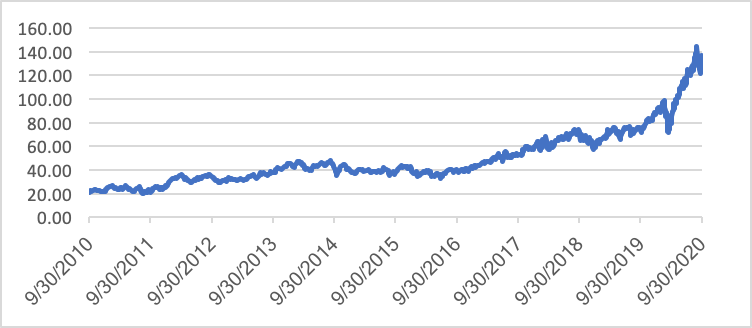
Unlike mutual funds, ETF shares are bought and sold at market price, which may be higher or lower than their NAV, and are not individually redeemed from the fund. ETFs are subject to management fees and other expenses. ETFs are subject to market fluctuation and the risks of their underlying investments. The sale of ETFs is subject to an activity assessment fee (from $0.01 to $0.03 per $1,000 of principal).
#Qqq expense ratio free
(AAPL): Free Stock Analysis Report Microsoft Corporation (MSFT): Free Stock Analysis Report Invesco QQQ (QQQ): ETF Research Reports Vanguard Growth ETF (VUG): ETF Research Reports To read this article on click here.Free commission offer applies to online purchases select ETFs in a Fidelity brokerage account. (AMZN): Free Stock Analysis Report Apple Inc. Click to get this free report Invesco NASDAQ 100 ETF (QQQM): ETF Research Reports , Inc.
#Qqq expense ratio download
VUG has an expense ratio of 0.04% and QQQ charges 0.20%.Bottom-LineWhile an excellent vehicle for long term investors, passively managed ETFs are a popular choice among institutional and retail investors due to their low costs, transparency, flexibility, and tax efficiency.To learn more about this product and other ETFs, screen for products that match your investment objectives and read articles on latest developments in the ETF investing universe, please visit Zacks ETF Center.Want key ETF info delivered straight to your inbox? Zacks’ free Fund Newsletter will brief you on top news and analysis, as well as top-performing ETFs, each week.Get it free >Want the latest recommendations from Zacks Investment Research? Today, you can download 7 Best Stocks for the Next 30 Days. While Vanguard Growth ETF has $76.25 billion in assets, Invesco QQQ has $176.90 billion. There are other additional ETFs in the space that investors could consider as well.The Vanguard Growth ETF (VUG) and the Invesco QQQ (QQQ) track a similar index. Because of this, QQQM is an excellent option for investors seeking exposure to the Style Box - Large Cap Growth segment of the market.

With about 104 holdings, it effectively diversifies company-specific risk.AlternativesInvesco NASDAQ 100 ETF holds a Zacks ETF Rank of 2 (Buy), which is based on expected asset class return, expense ratio, and momentum, among other factors.

In the past 52-week period, it has traded between $130.26 and $166.07.The ETF has a beta of 1.09 and standard deviation of 21.50% for the trailing three-year period. The NASDAQ-100 Index includes securities of 100 of the largest domestic and international nonfinancial companies listed on Nasdaq.The ETF has lost about -17.82% so far this year and is down about -2.30% in the last one year (as of ). Consumer Discretionary and Telecom round out the top three.Looking at individual holdings, Apple Inc (AAPL) accounts for about 12.56% of total assets, followed by Microsoft Corp (MSFT) and Inc (AMZN).The top 10 holdings account for about 52.2% of total assets under management.Performance and RiskQQQM seeks to match the performance of the NASDAQ-100 INDEX before fees and expenses. Luckily, most ETFs are very transparent products that disclose their holdings on a daily basis.This ETF has heaviest allocation to the Information Technology sector-about 50.10% of the portfolio. They are likely to outperform value stocks in strong bull markets but over the longer-term, value stocks have delivered better returns than growth stocks in almost all markets.CostsSince cheaper funds tend to produce better results than more expensive funds, assuming all other factors remain equal, it is important for investors to pay attention to an ETF's expense ratio.Annual operating expenses for this ETF are 0.15%, making it one of the least expensive products in the space.It has a 12-month trailing dividend yield of 0.51%.Sector Exposure and Top HoldingsEven though ETFs offer diversified exposure which minimizes single stock risk, it is still important to look into a fund's holdings before investing. Also, growth stocks are a type of equity that carries more risk compared to others. They tend to be stable companies with predictable cash flows and are usually less volatile than mid and small cap companies.While growth stocks do boast higher than average sales and earnings growth rates, and they are expected to grow faster than the wider market, investors should note these kinds of stocks have higher valuations.

It has amassed assets over $4.11 billion, making it one of the larger ETFs attempting to match the Large Cap Growth segment of the US equity market.Why Large Cap GrowthCompanies that fall in the large cap category tend to have a market capitalization above $10 billion. Designed to provide broad exposure to the Large Cap Growth segment of the US equity market, the Invesco NASDAQ 100 ETF (QQQM) is a passively managed exchange traded fund launched on.


 0 kommentar(er)
0 kommentar(er)
